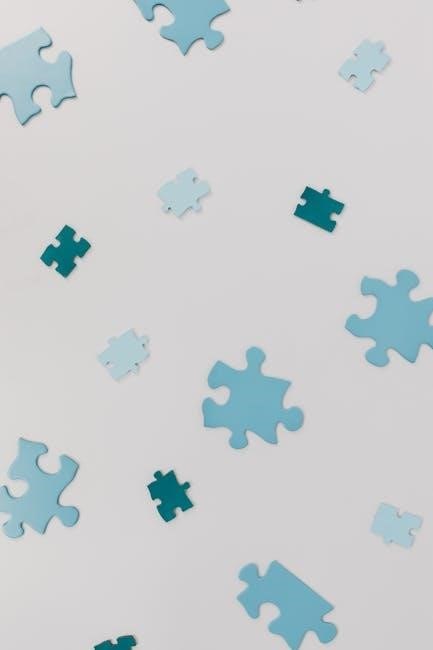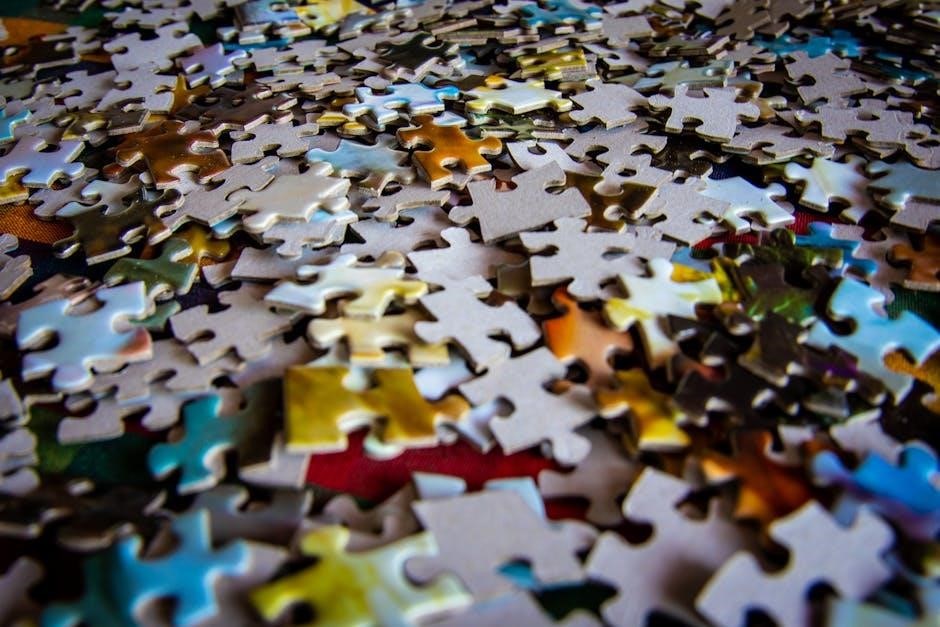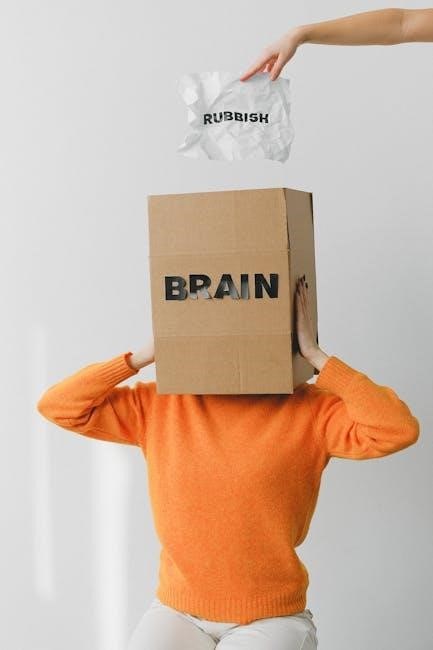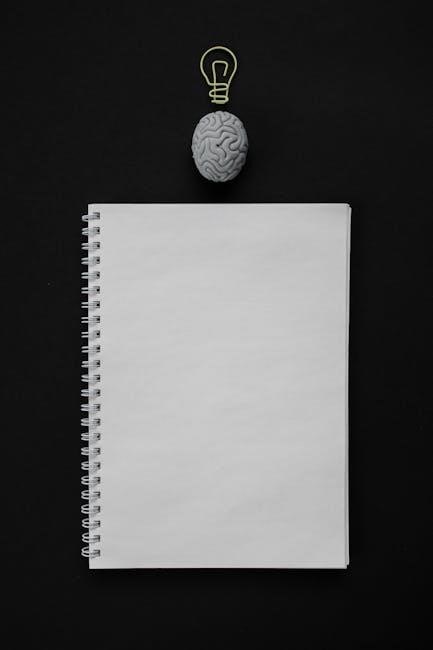The brain has several parts including cerebral cortex and brain stem
Overview of the Brain Structure
The brain is a complex organ that consists of several parts, including the cerebral cortex, brain stem, and cerebellum․ The cerebral cortex is the largest part of the brain and is responsible for controlling various functions such as thinking, perceiving, and understanding language․ The brain stem connects the brain to the spinal cord and regulates automatic functions like breathing, heart rate, and blood pressure․ The brain is divided into two hemispheres, the right and left, which are connected by the corpus callosum․ Each hemisphere has four lobes, including the frontal, parietal, temporal, and occipital lobes․ The brain structure is highly developed and plays a crucial role in controlling various bodily functions․ The different parts of the brain work together to enable us to think, learn, and function normally․ Understanding the brain structure is essential to appreciate its functions and importance in our daily lives․ The brain is a vital organ that requires proper care and maintenance to function optimally․ Proper nutrition, exercise, and rest are essential for maintaining brain health․

Lobes of the Brain

Brain has four lobes including frontal, parietal, temporal, occipital lobes
Frontal Lobe and its Functions
The frontal lobe is responsible for various higher-order functions, including decision-making, problem-solving, and motor control․ It is also involved in language processing, memory, and attention․ The frontal lobe is divided into different sections, each with distinct functions․ The prefrontal cortex, for example, is responsible for executive functions, such as planning and organization․ The premotor cortex, on the other hand, is involved in motor planning and coordination․ Damage to the frontal lobe can result in significant cognitive and behavioral impairments, including difficulties with speech, memory, and decision-making․ The frontal lobe is also involved in emotional regulation, and damage to this area can lead to mood disturbances and personality changes․ Overall, the frontal lobe plays a critical role in many aspects of human behavior and cognition, and its functions are essential for everyday life․ The frontal lobe is a complex and highly developed region of the brain, and its functions continue to be the subject of ongoing research and study․
Occipital Lobe and its Functions
The occipital lobe is primarily responsible for processing visual information․ It is located at the back of the brain and is the smallest of the four lobes․ The occipital lobe receives visual input from the eyes and is involved in the interpretation of visual stimuli, including color, shape, and movement․ It is also responsible for the recognition of objects and patterns․ The occipital lobe is highly specialized, with different areas processing different types of visual information․ Damage to the occipital lobe can result in visual impairments, including blindness or difficulty perceiving visual stimuli․ The occipital lobe works in conjunction with other areas of the brain to facilitate visual perception and interpretation․ It is a critical component of the visual system and plays a vital role in our ability to navigate and understand the world around us․ The occipital lobe is a complex and highly specialized region of the brain, and its functions are essential for everyday life․

Temporal Lobe and its Functions
Temporal lobe processes auditory information and plays role in memory and language functions effectively always
Role of the Temporal Lobe in Memory and Sensory Processing
The temporal lobe plays a crucial role in processing sensory information and forming memories․ It is involved in the interpretation of auditory and visual information, and is also responsible for the formation and storage of new memories․ The temporal lobe is divided into two main parts: the lateral temporal lobe and the medial temporal lobe․ The lateral temporal lobe is involved in the processing of auditory information, while the medial temporal lobe is involved in the formation and storage of new memories․ The temporal lobe also contains the hippocampus, which is a structure that is critical for the formation of new memories․ Damage to the temporal lobe can result in difficulties with memory and sensory processing, and can also lead to conditions such as epilepsy and Alzheimer’s disease․ The temporal lobe is a complex and important structure that is essential for our ability to process and understand the world around us․ It is a vital part of our brain and is necessary for our survival․
Location and Function of the Temporal Lobe
The temporal lobe is located on the sides of the brain, near the temples․ It is one of the four major lobes of the brain, and is involved in a variety of functions, including processing auditory information, memory, and language․ The temporal lobe is also involved in the processing of sensory information, including sound, smell, and taste․ It is a critical structure for our ability to understand and interpret the world around us․ The temporal lobe is divided into two main parts: the superior temporal gyrus and the middle temporal gyrus․ The superior temporal gyrus is involved in the processing of auditory information, while the middle temporal gyrus is involved in the processing of visual information․ The temporal lobe is a complex and important structure that is essential for our ability to process and understand sensory information․ It plays a critical role in our daily lives, and is necessary for our survival and well-being, making it a vital part of our brain․

Other Parts of the Brain
Brain parts include cerebellum, pituitary gland, and hypothalamus regulating
Brain Stem and its Functions
The brain stem is a vital part of the brain that connects the cerebrum to the spinal cord․ It is responsible for controlling many of the automatic functions of the body, such as breathing, heart rate, and blood pressure․ The brain stem is made up of three main parts: the midbrain, pons, and medulla oblongata․ Each of these parts has distinct functions and plays a crucial role in maintaining the body’s homeostasis․ The brain stem also regulates the body’s sleep-wake cycle, also known as the circadian rhythm․ Additionally, it helps to control the body’s reflexes, such as swallowing, coughing, and sneezing․ The brain stem is a critical component of the brain and is essential for maintaining the body’s overall health and function․ It works in conjunction with other parts of the brain to ensure that the body’s systems are functioning properly․ The brain stem’s functions are necessary for survival․
Cerebral Cortex and its Components
The cerebral cortex is the outer layer of the brain and is responsible for processing sensory information, controlling movement, and managing higher-level cognitive functions․ It is divided into two hemispheres, the left and right, which are connected by the corpus callosum․ The cerebral cortex is composed of four main lobes: frontal, parietal, temporal, and occipital․ Each lobe has distinct functions and is responsible for processing different types of information․ The cerebral cortex is also responsible for controlling voluntary movements, such as walking, talking, and writing․ It is the most highly developed part of the brain and is responsible for many of the brain’s higher-level functions․ The cerebral cortex is a complex structure that is essential for maintaining the body’s overall health and function․ It works in conjunction with other parts of the brain to ensure that the body’s systems are functioning properly․ The cerebral cortex’s components work together to enable the brain to function normally․
